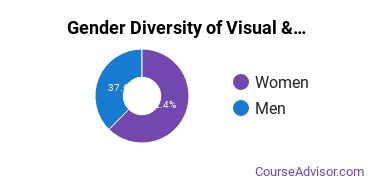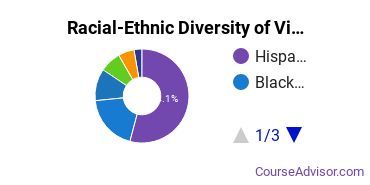Visual & Performing Arts at California State University - Dominguez Hills
What traits are you looking for in a visual and performing arts school? To help you decide if California State University - Dominguez Hills is right for you, we've gathered the following information about the school's visual and performing arts program.CSUDH is located in Carson, California and has a total student population of 18,687. Of the 3,776 students who graduated with a bachelor’s degree from California State University - Dominguez Hills in 2021, 109 of them were visual and performing arts majors.
Want to know more about the career opportunities in this field? Check out the Careers in Visual & Performing Arts section at the bottom of this page.
Featured schools near , edit
CSUDH Visual & Performing Arts Degrees Available
- Bachelor’s Degree in Visual & Performing Arts
CSUDH Visual & Performing Arts Rankings
Each year, College Factual ranks visual and performing arts programs across the country. The following shows how CSUDH performed in these rankings.
Note: Rankings don't always give a complete picture of a school's strengths and weaknesses, so it's a good idea to extend your research and also look at other factors when trying to decide if the school is right for you.
Bachelor’s Degree Overall Quality & Other Notable Rankings
The visual and performing arts major at CSUDH is not ranked on College Factual’s Best Colleges and Universities for Visual & Performing Arts. This could be for a number of reasons, such as not having enough data on the major or school to make an accurate assessment of its quality.
| Ranking Type | Rank |
|---|---|
| Most Popular Visual & Performing Arts Graduate Certificate Schools | 116 |
| Most Focused Visual & Performing Arts Graduate Certificate Schools | 116 |
| Most Popular Visual & Performing Arts Bachelor’s Degree Schools | 239 |
| 519 |
Visual & Performing Arts Student Demographics at CSUDH
Take a look at the following statistics related to the make-up of the visual and performing arts majors at California State University - Dominguez Hills.
CSUDH Visual & Performing Arts Bachelor’s Program

Prospective students may be interested in knowing that this school graduates 52% more racial-ethnic minorities in its visual and performing arts bachelor's program than the national average.*
The following table and chart show the race/ethnicity for students who recently graduated from California State University - Dominguez Hills with a bachelor's in visual and performing arts.

| Race/Ethnicity | Number of Students |
|---|---|
| Asian | 12 |
| Black or African American | 21 |
| Hispanic or Latino | 59 |
| White | 8 |
| International Students | 3 |
| Other Races/Ethnicities | 6 |
CSUDH also has a doctoral program available in visual and performing arts. In 2021, 0 student graduated with a doctor's degree in this field.
Concentrations Within Visual & Performing Arts
Visual & Performing Arts majors may want to concentrate their studies in one of these areas. The table shows all degrees awarded in this field awarded for all degree levels at California State University - Dominguez Hills. A concentration may not be available for your level.
| Concentration | Annual Degrees Awarded |
|---|---|
| Fine & Studio Arts | 45 |
| Film, Video & Photographic Arts | 32 |
| Drama & Theater Arts | 19 |
| Music | 13 |
Related Majors
- Philosophy & Religious Studies
- Foreign Languages & Linguistics
- English Language & Literature
- Liberal Arts / Sciences & Humanities
Careers That Visual & Performing Arts Grads May Go Into
A degree in visual and performing arts can lead to the following careers. Since job numbers and average salaries can vary by geographic location, we have only included the numbers for CA, the home state for California State University - Dominguez Hills.
| Occupation | Jobs in CA | Average Salary in CA |
|---|---|---|
| High School Teachers | 112,960 | $80,510 |
| Managers | 66,300 | $143,350 |
| Graphic Designers | 29,320 | $61,100 |
| Producers and Directors | 25,320 | $115,080 |
References
*The racial-ethnic minorities count is calculated by taking the total number of students and subtracting white students, international students, and students whose race/ethnicity was unknown. This number is then divided by the total number of students at the school to obtain the racial-ethnic minorities percentage.
More about our data sources and methodologies.
Featured Schools
 Request Info
Request Info
|
Southern New Hampshire University You have goals. Southern New Hampshire University can help you get there. Whether you need a bachelor's degree to get into a career or want a master's degree to move up in your current career, SNHU has an online program for you. Find your degree from over 200 online programs. Learn More > |
